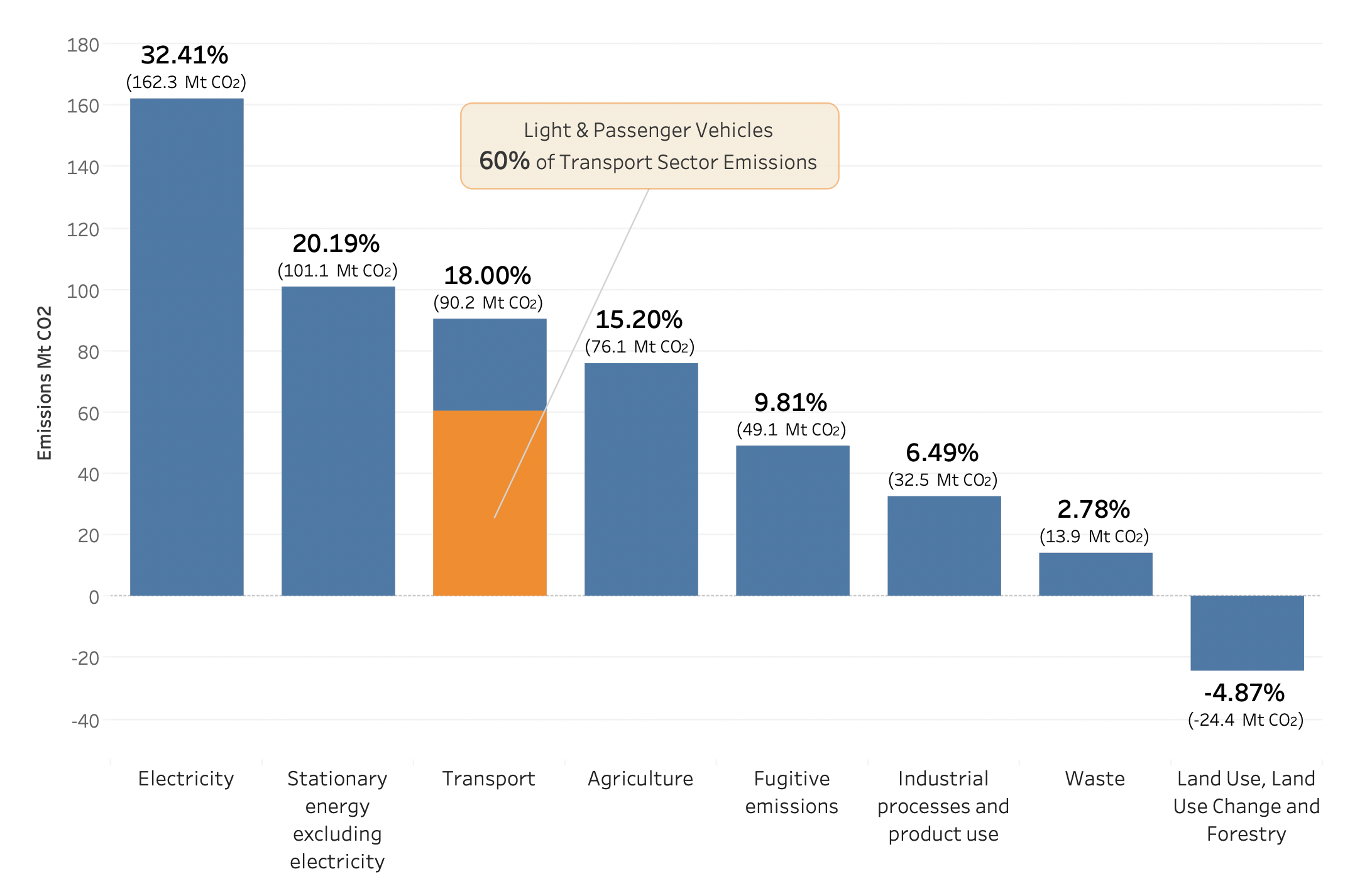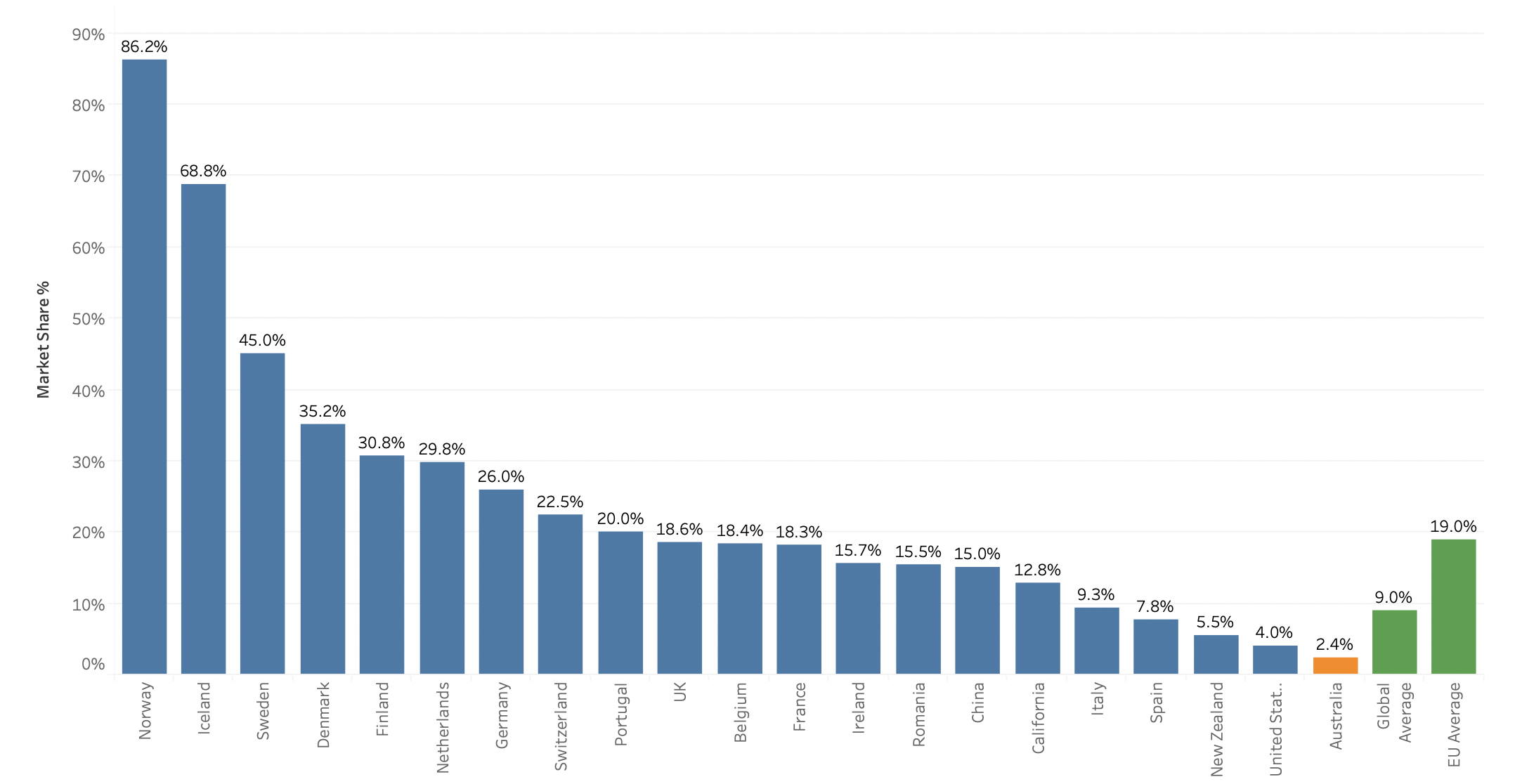
I woke up the day after the Australian election, and for the first time in years, I wasn't embarrassed by our government, which for the past decade was locked into a climate change delay tactic. Hopefully, this marks the dawn of more progressive thinking on climate change. It is very encouraging, but we need the momentum to continue. If like me, you voted for this change, it's no time to sit back and relax, but time to put these ideas into practice.
One area that did not get much attention during the election campaign was the topic of vehicle emission standards. I think it's embarrassing that a rich country like Australia lags behind the rest of the world in this area. I would consider this a 'low hanging fruit' policy. Its uptake will have a positive and significant impact in addressing our environmental issues and contribute to social and economic benefits.
Let me explain why we should aim to sign this into law as soon as possible.
In 2021, transport accounted for over 18% (91Mt CO2) of Australia's greenhouse gas (GHG) emissions (figure 1), making it the 3rd most significant source. Almost two thirds (60Mt CO2) of that can be accounted for by the light vehicle sector. On a per capita bases, transport emissions in Australia are higher than in most other countries. The reason is partly due to our high dependence on road transport and willingness to accept inefficient vehicles compared to other developed nations.
We only need to look at the EU to see first-hand a successful implementation of such policy. In a single year, in 2020, the average CO2 emissions from new passenger cars registered in Europe decreased by 12%. In addition, the share of electric vehicles tripled as new targets came into effect.

Why is this a problem?
Vehicle emission standards are commonplace worldwide, and not having them in Australia puts us at a disadvantage.
-
Australians cannot buy advanced, modern cars because fuel quality is too low. Many experts claim Australia is becoming a 'dumping ground' for less safe and less efficient vehicles, which other nations reject.
-
Due to sales of outdated and inefficient Internal Combustion Engine (ICE) cars, the Australian population is exposed to particulate matter, hydrocarbons, carbon monoxide and other car pollutants. All contribute to the poorer health of its citizens and higher health services costs.
-
The inefficiency also contributes the higher greenhouse gas (GHG) emissions. The latest average emissions intensity for new passenger and light SUV vehicles in Australia is 150g of CO2/km. Compare this to the European average of 95g of CO2/km, a significant difference.
-
The number of available EV models is limited in Australia. In early 2021 Australian consumers had access to only 18 zero-emission Battery Electric Vehicles (BEV) models. Most EVs on that list are premium brands and models with prices above $60,000. For comparison, the worldwide EV market featured 235 models in 2020, spanning a wide price range.
-
Australia is lagging in EV uptake, with just 2.4% of all new cars sold being electric, compared to the global average of 9% and the EU average of 19% (figure 2). It is disappointing for a country known for being an early adopter of new technologies. As the data shows, this is not due to the lack of demand. On the contrary, as an example, annual allocations of the new Hyundai Ioniq 5 were 40 times oversubscribed, and the limited number of cars were snapped up in minutes. The limiting factor is due to the deliberate choice of many car manufacturers to bypass the Australian market. Unsurprisingly, this is partly due to the lack of government incentives but more significantly due to the lack of emissions standards, targets, and penalties. Financially it makes sense for them to sell EVs in Europe, where every gram of CO2 emission over the threshold attracts a heavy fine (see next section for EU regulations).
-
Consumers have no choice but to buy inefficient engines that burn more fuel and cost more to run. Based on the current models available in Australia, the average fuel consumption is around 6.44 litres per 100km compared to the average consumption in Europe of just 4.09 litres per 100km. Assuming the typical travel of 15,000 per year and the fuel price at $2.20, Australian consumers are paying $775 more annually at the bowser. This value is a conservative estimate as standard and large SUVs were excluded from this calculation.
-
The average age of vehicles across Australia is 10.6 years (Australian Bureau of Statistics, 2021). Every year of delay will have negative consequences for many years.

The benefits outweigh the costs.
I am sure you agree that the long list above is an unnecessary burden on the economy and the environment. But, it can be easily fixed with the right policy. It is, therefore, crucial to continue and pressure policymakers to adopt strict European vehicle emission standars in Australia. Such laws reward low emission technologies and penalise laggards. You can read a summary of the key features currently implemented in the EU at the end of this post.
The result of such policy will have undeniable and positive environmental, social and economic outcomes.
Environmental benefit
-
More efficient ICE vehicles in the near future and a growing fleet of EVs in the long term will lower the CO2 emissions.
-
The passenger and light vehicle sector can significantly contribute (12% of all CO2 emissions) to meeting Australia's 2030 emissions commitments and future target of net-zero by 2050.
Economic benefits
-
Australian consumers will benefit by paying less for fuel. Currently, they are unnecessarily using more fuel and paying more than required. Our calculations show an average annual saving of $775.
-
The increasing number of EVs will require new charging infrastructure, creating jobs. Today, there are 291 fast-charging (DC) and 1580 regular-charging (AC) public locations in Australia. Additional 700 fast-charging locations are planned over the next five years (Electric Vehicle Council, 2022). The demand will only accelerate with higher EV uptake.
-
The long term financial benefit of adopting European style vehicle emissions standards overwhelmingly outweighs the extra initial cost of $1,500 per vehicle.
Social and health benefits
-
The policy change will gradually eliminate harmful air pollution from ICE vehicles leading to better health outcomes.
-
The increase in the number of near-silent EVs will result in lower noise pollution leading to better mental health outcomes in ever-growing and more congested cities.
-
The benefit of a more competitive marketplace for efficient ICE vehicles and EVs will result in more choices and cheaper models for consumers.
The original aim of the vehicle emissions standard was to improve the efficiency of current and future ICE vehicles. But improved efficiency is not the ultimate goal. The end goal is to eliminate fossil fuels from the transportation sector, which is critical in meeting the net-zero target by 2050 or earlier.
Support for this policy is crucial as the means to orderly remove all ICE vehicles from our roads with the least disruption to our economy, environment, and social fabric. Many car manufacturers are already committed to eliminating ICE vehicles from their fleets. Australia needs to be part of this transition today.
And finally, a modern vehicle emission standard in Australia will remove barriers that stand in the way of many Australians wanting to contribute to a net-zero future.
How does this work in the EU?
The EU introduced a compulsory CO2 vehicle emissions standard for new passenger cars in 2009. Over the years, the regulation has evolved, with each release lowering the target emissions measured in grams of CO2 per km travel (g/km). As of 2021, manufacturers of passenger cars registered in Europe must meet the target of 95g/km as the average emission across their fleet in a given year. Considerations are given based on the average mass of the manufacturer's new vehicles registered annually. Pooling where manufacturers can group together is allowed within the rules, and exemptions for niche manufacturers are also possible. In addition, extra incentives and credits are given to zero and low-emission (<50g/km) vehicles.
The current objective will only last for four years, and lowering the target will continue with a 15% reduction from 2025 on and a 37.5% reduction from 2030 on.
At the core of these regulations are penalties for excess emissions. Manufacturers will have to pay an excess emissions premium of €95 for every gram of CO2/km per car that exceeds the target. This can result in multimillion Euro fines.
.